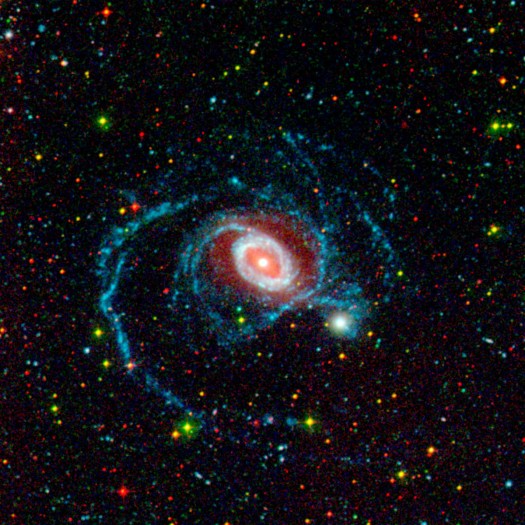Invisible Spiral Arms
March 2008By by Patrick Barry
by Patrick Barry;Now consider this: many of the galaxies you've seen are actually much larger than they appear. NASA's Galaxy Evolution Explorer, a space telescope that “sees” invisible, ultraviolet light, has revealed that roughly 20 percent of nearby galaxies have spiral arms that extend far beyond the galaxies' apparent edges. Some of these galaxies are more than three times larger than they appear in images taken by ordinary visible-light telescopes.
“Astronomers have been observing some of these galaxies for many, many years, and all that time, there was a whole side to these galaxies that they simply couldn't see,” says Patrick Morrissey, an astronomer at Caltech in Pasadena, California, who collaborates at JPL.
The extended arms of these galaxies are too dim in visible light for most telescopes to detect, but they emit a greater amount of UV light. Also, the cosmic background is much darker at UV wavelengths than it is for visible light. “Because the sky is essentially black in the UV, far-UV enables you to see these very faint arms around the outsides of galaxies,” Morrissey explains.
These “invisible arms” are made of mostly young stars shining brightly at UV wavelengths. Why UV? Because the stars are so hot. Young stars burn their nuclear fuel with impetuous speed, making them hotter and bluer than older, cooler stars such as the sun. (Think of a candle: blue flames are hotter than red ones.) Ultraviolet is a sort of “ultra-blue” that reveals the youngest, hottest stars of all.
“That's the basic idea behind the Galaxy Evolution Explorer in the first place. By observing the UV glow of young stars, we can see where star formation is active,” Morrissey says.
The discovery of these extended arms provides fresh clues for scientists about how some galaxies form and evolve, a hot question right now in astronomy. For example, a burst of star formation so far from the galaxies' denser centers may have started because of the gravity of neighboring galaxies that passed too close. But in many cases, the neighboring galaxies have not themselves sprouted extended arms, an observation that remains to be explained. The Galaxy Evolution Explorer reveals one mystery after another!
“How much else is out there that we don't know about?” Morrissey asks. “It makes you wonder.”
Spread the wonder by seeing for yourself some of these UV images at www.galex.caltech.edu. Also, Chris Martin, principle scientist for Galaxy Evolution Explorer —or rather his cartoon alter-ego—gives kids a great introduction to ultraviolet astronomy at spaceplace.nasa.gov/en/kids/live#martin.

In this image of galaxy NGC 1512, red represents its visible light appearance, the glow coming from older stars, while the bluish-white ring and the long, blue spiral arms show the galaxy as the Galaxy Evolution Explorer sees it in ultraviolet, tracing primarily younger stars. (Credit: NASA/JPL-Caltech/DSS/GALEX).

Galaxy NGC 1512 is represented in both images. The visible light image on the left shows the glow of older stars, while the Galaxy Evolution Explorer ultraviolet image on the right shows the ring and long, spiral arms, tracing primarily younger stars. (Credit: NASA/JPL-Caltech/DSS/GALEX).
This article was provided by the Jet Propulsion Laboratory, California Institute of Technology, under a contract with the National Aeronautics and Space Administration.



